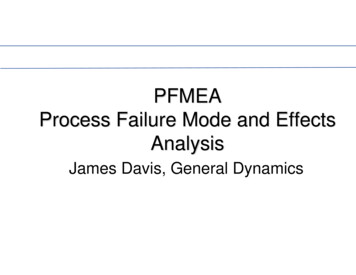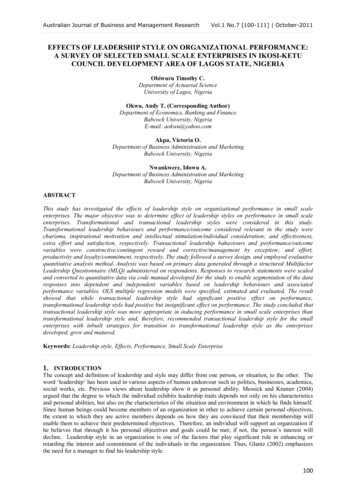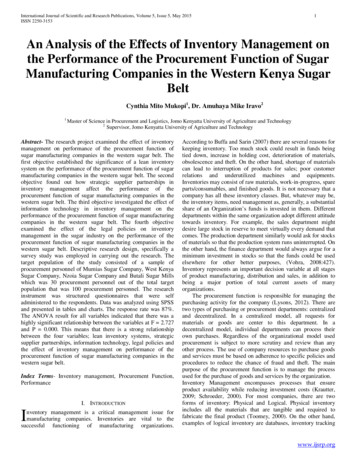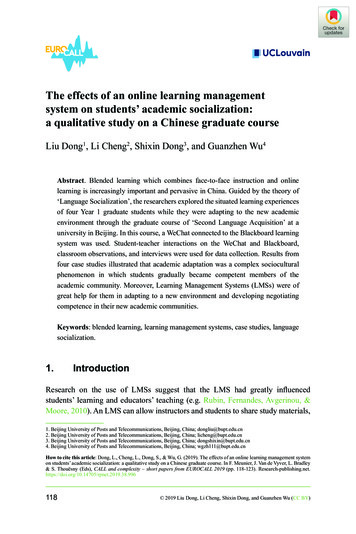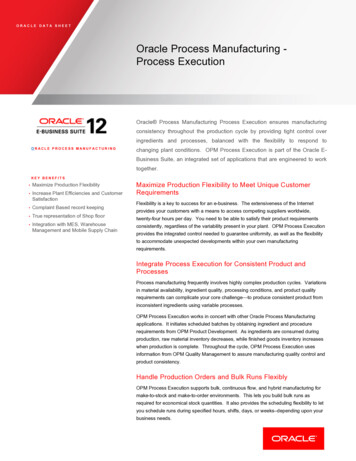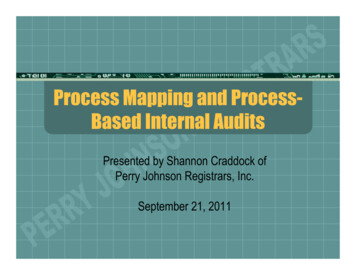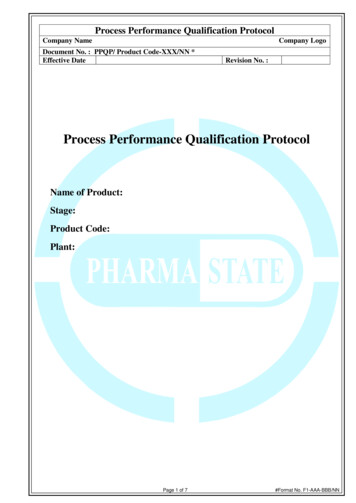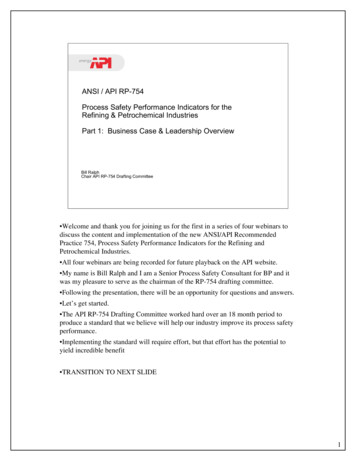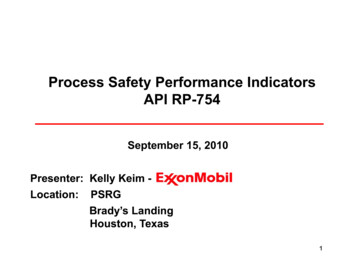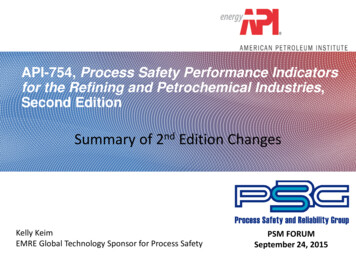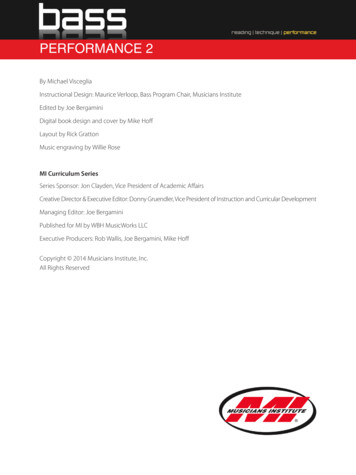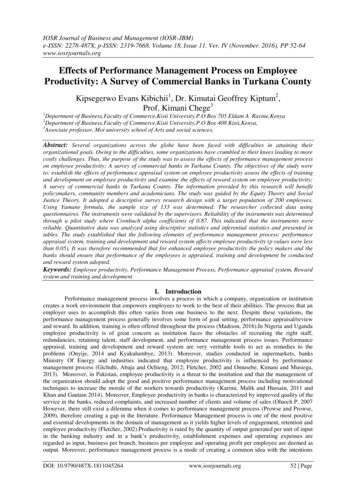
Transcription
IOSR Journal of Business and Management (IOSR-JBM)e-ISSN: 2278-487X, p-ISSN: 2319-7668. Volume 18, Issue 11. Ver. IV (November. 2016), PP 52-64www.iosrjournals.orgEffects of Performance Management Process on EmployeeProductivity: A Survey of Commercial Banks in Turkana CountyKipsegerwo Evans Kibichii1, Dr. Kimutai Geoffrey Kiptum2,Prof. Kimani Chege31Department of Business,Faculty of Commerce,Kisii University,P.O Box 705 Eldam A Ravine,KenyaDepartment of Business,Faculty of Commerce,Kisii University,P.O Box 408 Kisii,Kenya,3Associate professor, Moi university school of Arts and social sciences,2Abstract: Several organizations across the globe have been faced with difficulties in attaining theirorganizational goals. Owing to the difficulties, some organizations have crumbled to their knees leading to morecostly challenges. Thus, the purpose of the study was to assess the effects of performance management processon employee productivity; A survey of commercial banks in Turkana County. The objectives of the study wereto: establish the effects of performance appraisal system on employee productivity assess the effects of trainingand development on employee productivity and examine the effects of reward system on employee productivity;A survey of commercial banks in Turkana County. The information provided by this research will benefitpolicymakers, community members and academicians. The study was guided by the Equity Theory and SocialJustice Theory. It adopted a descriptive survey research design with a target population of 200 employees.Using Yamane formula, the sample size of 133 was determined. The researcher collected data usingquestionnaires. The instruments were validated by the supervisors. Reliability of the instruments was determinedthrough a pilot study where Cronbach alpha coefficients of 0.87. This indicated that the instruments werereliable. Quantitative data was analyzed using descriptive statistics and inferential statistics and presented intables. The study established that the following elements of performance management process: performanceappraisal system, training and development and reward system affects employee productivity (p values were lessthan 0.05). It was therefore recommended that for enhanced employee productivity the policy makers and thebanks should ensure that performance of the employees is appraised, training and development be conductedand reward system adopted.Keywords: Employee productivity, Performance Management Process, Performance appraisal system, Rewardsystem and training and developmentI. IntroductionPerformance management process involves a process in which a company, organization or institutioncreates a work environment that empowers employees to work to the best of their abilities. The process that anemployer uses to accomplish this often varies from one business to the next. Despite these variations, theperformance management process generally involves some form of goal setting, performance appraisal/reviewand reward. In addition, training is often offered throughout the process (Madison, 2016).In Nigeria and Ugandaemployee productivity is of great concern as institution faces the obstacles of recruiting the right staff,redundancies, retaining talent, staff development, and performance management process issues. Performanceappraisal, training and development and reward system are very veritable tools to act as remedies to theproblems (Onyije, 2014 and Kyakulumbye, 2013). Moreover, studies conducted in supermarkets, banksMinistry Of Energy and industries indicated that employee productivity is influenced by performancemanagement process (Gichuhi, Abaja and Ochieng, 2012; Fletcher, 2002 and Omusebe, Kimani and Musiega,2013). Moreover, in Pakistan, employee productivity is a threat to the institution and that the management ofthe organization should adopt the good and positive performance management process including motivationaltechniques to increase the morale of the workers towards productivity (Karimi, Malik and Hussain, 2011 andKhan and Gautam 2014). Moreover, Employee productivity in banks is characterized by improved quality of theservice in the banks, reduced complaints, and increased number of clients and volume of sales (Oluoch P. 2007However, there still exist a dilemma when it comes to performance management process (Prowse and Prowse,2009), therefore creating a gap in the literature. Performance Management process is one of the most positiveand essential developments in the domain of management as it yields higher levels of engagement, retention andemployee productivity (Fletcher, 2002).Productivity is rated by the quantity of output generated per unit of inputin the banking industry and in a bank‟s productivity, establishment expenses and operating expenses areregarded as input, business per branch, business per employee and operating profit per employee are deemed asoutput. Moreover, performance management process is a mode of creating a common idea with the intentionsDOI: 10.9790/487X-1811045264www.iosrjournals.org52 Page
Effects of Performance Management Process on Employee Productivity: A Survey of Commercialand goals of the organization, helping each individual employee undertake and know the role play incontributing to them (Fletcher, 2002). Therefore, thriving organizational change depends on managementcommitment, the stronger the commitment the greater the potential for employee productivity (Armstrong andBaron, 2004). Banking sector in Kenya has been characterized by low employee productivity attributed byinadequate performance management process (Oluoch P. 2007) and banks in Turkana County are not exempted.In an effort to alleviate some of these challenges, the Central Bank of Kenya has in the past launched severalreform programs including performance management process whose aim was to enhance productivity (CBK,2014). This study therefore assessed the effects of performance management process on employee productivity;A survey of commercial banks in Turkana County.1.2 Statement of the ProblemThe crucial HRM obstacles of recruiting the right staff, redundancies, retaining talent, staffdevelopment, salary inflation and other threats that are external as well as the varying working conditions andre-skilling has raised concern among banking stakeholders (Hudson, 2004 and Jyothi, 2007). In TurkanaCounty, Commercial Banks experience the problems of the right staff recruitment, redundancies, retaining talentretention, staff development, salary inflation (CBK, 2014). Thus, performance management process ismomentously valuable to all organizations as it is likely to give a hand in ensuring employees are working hardtowards the attainment of organization's mission and objectives, hence, productivity (Omusebe, Kimani andMusiega, 2013).Whereas there has been an attempt to improve the situation of low employees productivity inBanking sector (Oluoch P. 2007), it seems not much has been achieved as local studies done on performancemanagement process and employee productivity focused in Ministry of Energy, industries, supermarkets andMinistry of State for Provincial Administration & Internal Security(Gichuhi, Abaja and Ochieng, 2012;Fletcher, 2002 and Omusebe, Kimani and Musiega, 2013), thus creating a gap, hence suggestion for furtherresearch in other sectors. This inspired the need to design the current research to fill in the existing gap byassessing the effects of performance management process on employee productivity; A survey of commercialbanks in Turkana County.II. Literature Review2.1Performance appraisal on employee productivityThe role of performance appraisal has moved beyond an instrument for assessing employees to one thatis used to reinforce the desired behavior and competent performance of the employees. Performance appraisal isthe single most powerful tool for marshalling employees in a sophisticated and well managed organization inorder to achieve strategic goals (Singh et al, 2010). A good performance appraisal system should developmethod for successful performance, give performance feedback and enable a more equitable reward system.Performance method forms the basis of evaluating the employees‟ performance and their contribution towardsthe organizational goal. It entails the desired outputs expected of employees. Performance method should be inline with goals, relevant to given roles, specific and measurable, under employees control and understood andaccepted by participants (Dattner, 2010).Al-Ahmadi (2009) affirms that performance enhancement is not only dependent on the wellfunctioning system but also on effective human resource strategies that succeed in hiring and Performanceappraisal as defined by (Robbins et al., 2000) states that, “it is the analysis of a person‟s work performance inorder to arrive at an objective personnel decision”. Boswell & Boudreau (2000, 2002) confirms that a number ofresearches on the rater effects have also been conducted. There are several methods of measuring employees‟performance; however a few of these methods are applicable in most occurrences. Decenzo and Robbins (2002),enumerate that there are three approaches of measuring employee‟s performance. These are (1) absolutestandards (2) relative standards and (3) objectives. According to Dessler, (2000) absolute Standards refer to astate where employees are evaluated against a standard and their evaluation is not dependent on any other coworker in their work bracket. This form of standard still remains the oldest method of performance appraisal onemployees. Included in this faction are the following methods: the essay appraisal, the critical incident appraisal,the checklist, the graphic rating scale, forced choice and behaviorally anchored rating scales. Sustaining adedicated and motivated workforce.Mondy (2008) asserts that in essay appraisal, the fundamental focus is on behaviors. The crucial detailis that appraisal focuses on vital features which make a difference in performing a job efficiently. This method ismore pragmatic because it is job related and its basis is on individual‟s performance than characteristic. Themajor obligation of this system is to measure individual‟s performance in terms of happenings and specialoccurrence which take place in job performance. These incidents are known as critical incident. In this method,the manager put pen to paper the positive and negative individuals‟ performance behavior in evaluation termMondy, (2008). Decenzo (2002) views the checklist method as one where the assessor takes a record ofconditions and statements and compares it with employees. The checklist is a complete detail of employee‟scharacteristics and performance. The results can be quantitative and give weight to characteristics. Answers ofDOI: 10.9790/487X-1811045264www.iosrjournals.org53 Page
Effects of Performance Management Process on Employee Productivity: A Survey of Commercialchecklist are often “Yes” or “No”. The scope of performance on which a worker is appraised is termed thecriteria of evaluation, Ivancevich (1998). Suggestion by Omaha (2002) is that a varied criterion is required to beable to evaluate job performance of an employee accurately. Mathis and Jackson (2003) had the opinion thatdata or information that oversees appraisal regarding the ability of employees to execute their job well are ofthree different types. Trait-based information, Behavior-based information, Result based information. Opatha(2002) maintains that trait-based information identifies a subjective character of the employee such as attitude,initiative or creativity.Weiss, (2001) specified that to be fruitful, the performance appraisal process must contain general threesteps: evaluation and job analysis, appraisal interview, and post-appraisal interview. During the initial step, boththe appraiser and the appraisee should prepare for the interview by considering job performance, jobresponsibilities, and employee professional objectives, goals for enhancing performance, and problems andconcerns about the job. In some cases the appraiser and the appraisee fill out forms with questions addressingthe previously cited topics. Next, administration and workers come together to establish goals for the periodbefore the next performance appraisal. It is vital that the appraisal process be a discussion, not a speech. Afterthe appraisal process, an organization must assess the system itself to see whether the process is helping toachieve designated organizational aims (Ryan and Deci, 2000). Performance appraisals are often linked toincentives such as raises and promotion for a employee whose performance is viewed as high, and job cuts for aworker whose performance is said to be low (Joison, 2001). According to Ishaq et al (2009), appraisal results areused in many organizations, either directly or indirectly, to help identify the better performing person whoshould be rewarded with the bigger available merit pay increases, bonuses and promotions.Mallaiah (2009) did a survey on management of employee expectations, performance and satisfactionin University Library and found that majority of the respondents felt that the performance appraisal systemfollowed in the library is based on work performance and ability to take responsibility. He also realized that thepragmatic proposals given by respondents to improve the existing performance appraisal system includedchanging the criteria used. Gortner et al (2007) indicated that one setback of performance appraisal toemployees is that, in many instances, employees are rated more on their ability to get along with the supervisorthan they are on actual performance. Singh et al (2010) who conducted an experimental study on the efficiencyof performance appraisal system in Oil and natural Gas Commission (ONGC) and found that all organizationsdepends on the impression of supervisors and management for giving rewards and punishments for employees.Performance appraisal and career strategy is or should be an integral part of a system of managingeffectively, providing feedback of employee„s performance and communicating individual success reportingregularly to the team progress, (HeizWeihrich, 2003). This makes employees appreciate themselves, themanagement and understand the importance of their contribution to the organization objective. Rewardingperformance happens at the close of performance period. The core activities incorporate evaluation ofemployee's endeavors and skills; converse on evaluation with employees, (McAfee and Chanmpagne, 2003). Itassesses the efficacy of the procedure in totality and its function in the realization of the whole organizationalperformance so as to facilitate changes and improvements and also present the feedback to the organization andto individual staff about their actual performance. The effectiveness of any establishment is contingent to theexcellence of its personnel. The best suited people must be originally selected into the workforce, motivated towork; and sound personnel promotion and training decisions must be made in filling non-entry level. Aneffective personnel performance evaluation system is a crucial cornerstone in this process, as it supplies the dataneeded for most of the required administrative decisions. This system is indeed of great value as it assumes avital responsibility in inspiring people to make the most out of their abilities in pursuing the organization's goals(Musgrove & Creighton, 2003). On evaluating and checking the response, managers or organizations ought toprovide the pay-for-performance.Financial appraisal is a useful tool to invent employee's passion for their work. In this stage, managersstill need to focus on developing staff to further improve performance, and their career progression in the future.Rewards represent important mechanisms by which employee behaviours can be aligned with the interests of theorganization, (Eisenhardt, 2009). Particularly, pay-for-performance is a reward practice that associates one's payincrement to one's performance, and could be used to direct, sustain, and motivate desirable behaviours, such asknowledge sharing, (Bartol & Srivastava ,2002), creativity, (Eisenhardt et al. 2008), quality (Cowherd andLevine, 2002) and customer satisfaction (Delaney and Huselid, 2006).Pay-for-performance establishes the behavioural principle by which incentives are apportioned and indoing so fortifies the affiliation of employee behaviour with organizational values and objectives. Therefore, if aworker attains his or her objectives pertaining performance, subsequently the employee receives a pay increase.This simple and visible link between pay and performance recognizes an employee for a specific level ofaccomplishment, therefore nurturing favorable work attitudes, such as contentment and commitment, (Henemanet al. 2008). Thus, the effectiveness of pay-for-performance has a direct influence on high levels of servicequality and desirable work attitudes. Performance appraisals present challenges of their own from the structuringDOI: 10.9790/487X-1811045264www.iosrjournals.org54 Page
Effects of Performance Management Process on Employee Productivity: A Survey of Commercialof the system, to the effective management of the process. In most cases, the challenge confronting performancemanagement is on the level of structure, mechanics, and practice. Often, managers, supervisors, and employeesalike are not convinced of the value of performance appraisals. They feel that it simply represents additionalwork and remain skeptical of the process. Implementing a structured appraisal process is no easy task, especiallysince it creates additional work for supervisors. The process places pressure on employees and forces them toestablish specific goals and adopt the behaviours necessary to achieve these goals. Also, the process placesemployees and supervisors in an uncomfortable position; where employees may feel they are being unfairlyjudged because they are being graded as if they were in school. Managers find it difficult to be candid andconstructive at the same time when conducting an appraisal session that involves negative feedback. However,to achieve institution„s goals and objectives, an effective system of providing feedback to employees must haveperiodic and objective performance feedback. Performance appraisal has been described as “the process ofidentifying, observing, measuring, and developing employee performance in organization” (Carrol & Scheider,2012).Mullins (2009) explains that performance appraisal is additional benefit to organizations that can helpidentify inefficient work practices or reveal potential problems, which are restricting the progress of thecompany. Derven (2010) believes that there is a straight connection between the job of an individual and thestrategic goals of the organization and this can directly increase the profits of the company. He gives anillustration that advantage can be accomplished when a company designs its appraisal systems on measuringcustomer satisfaction. Other benefits of Performance Appraisal are the identification of high performers andpoor performers as well as the identification of strengths and development areas (Jackson & Schuller, 2012).Resistance is another challenge facing performance appraisal (Dzinkowski, 2010). The appraisal process mayface opposition from the employees because of the terror of negative ratings. Therefore, the employees shouldbe enlightened about the purpose as well as the process of appraisal. Performance appraisal takes intoconsideration the previous performance of the employees and emphasizes on the improvement of the futureperformance of the employees. It gives the staff the opportunity to express their ideas and expectations for thestrategic goals of the company (Mullins, 2009).Performance appraisal aids in rating the performance of the employees and evaluate their contri
management process (Gichuhi, Abaja and Ochieng, 2012; Fletcher, 2002 and Omusebe, Kimani and Musiega, 2013). Moreover, in Pakistan, employee productivity is a threat to the institution and that the management of the organization should adopt the good and positive performance
